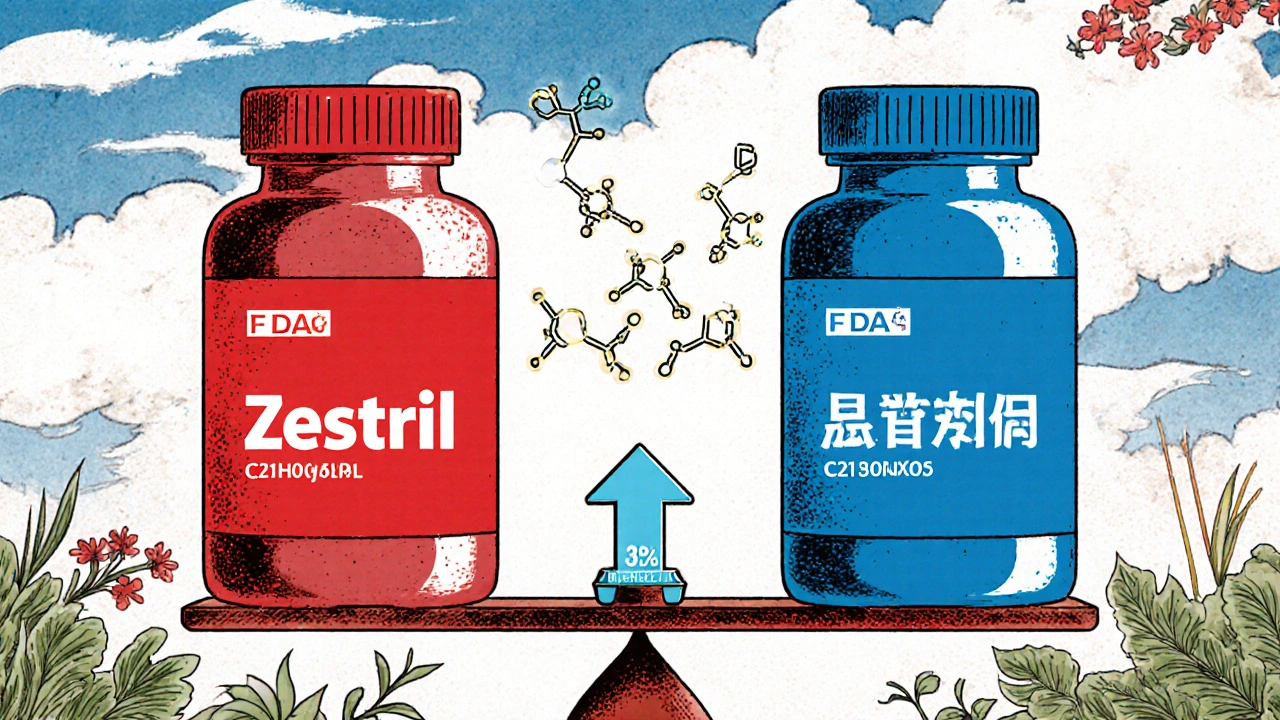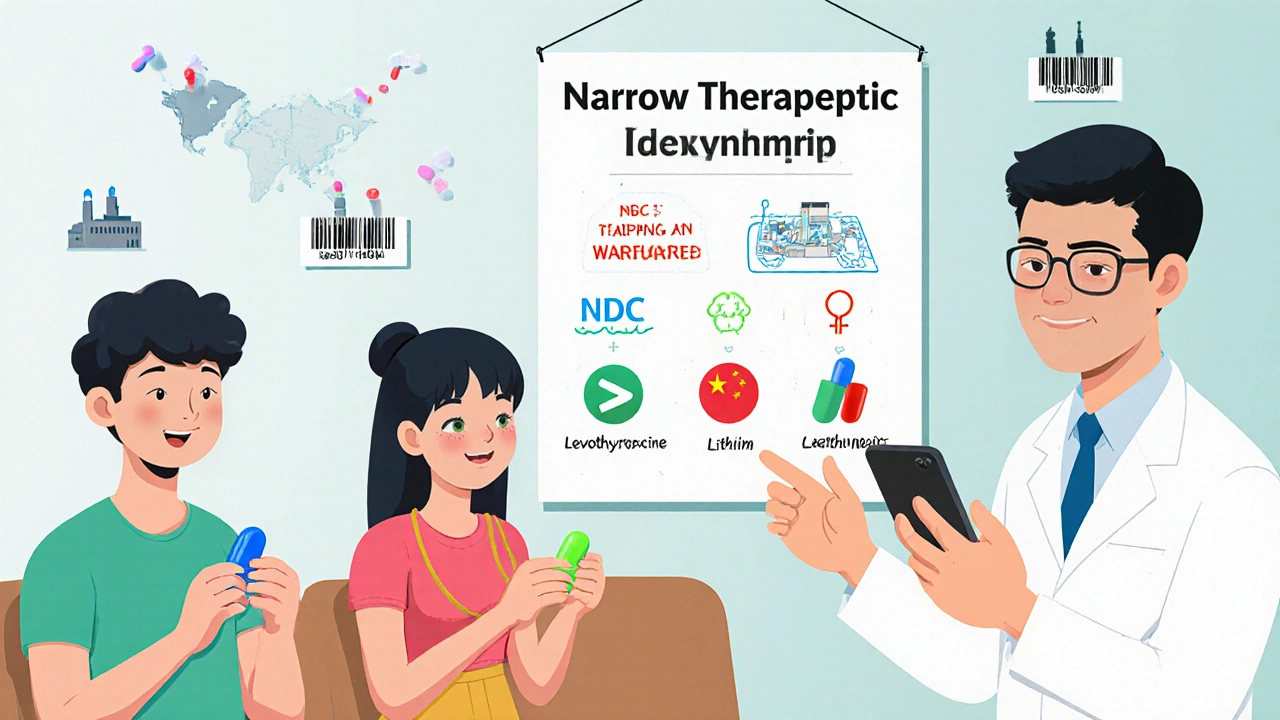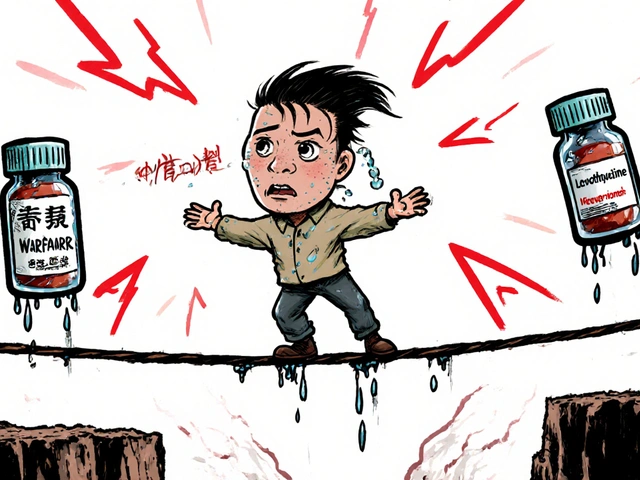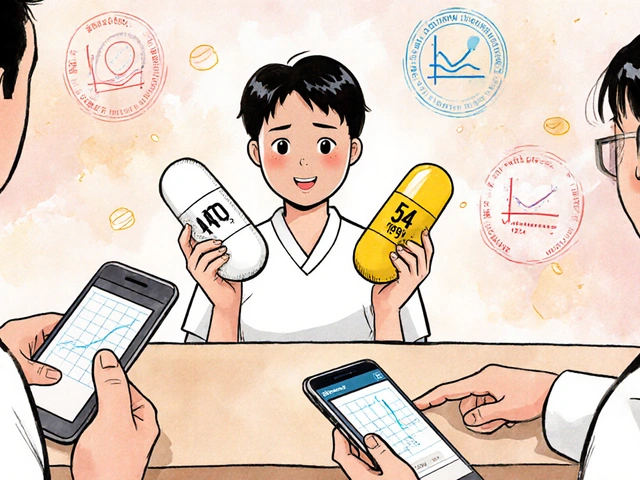When you pick up a prescription, you might notice something strange: the pill looks different. Maybe it’s blue instead of white, oval instead of round, or has a weird code stamped on it. You might panic-did the pharmacy give you the wrong medicine? Or worse, is it fake? The truth is, this happens all the time with generic drugs. And it’s completely legal.
Why Generic Pills Look Different
Generic drugs contain the exact same active ingredient as their brand-name counterparts. That means if you’re taking a generic version of lisinopril, you’re getting the same chemical that lowers your blood pressure as the brand-name Zestril. But here’s the catch: by law, generic pills cannot look identical to the brand version. This rule exists to protect trademarks. If a generic pill looked exactly like the brand, the original company could sue for copying their product’s appearance. That’s why manufacturers change the color, shape, size, or imprint. A generic version of 10mg amoxicillin might be a white oval with “APO” on one side, while another is a yellow capsule with “54 199.” Neither is wrong. Both contain the same amount of amoxicillin. The differences are cosmetic, not medical.What Makes a Generic Drug Safe
The U.S. Food and Drug Administration (FDA) requires every generic drug to prove it works the same way as the brand-name version. This is called bioequivalence. To meet this standard, the generic must deliver the same amount of active ingredient into your bloodstream at the same rate as the brand. The FDA’s acceptable range is 80% to 125% of the brand’s absorption levels. That’s not a wide gap-it’s tighter than the variation you’d see between two batches of the same brand-name drug made months apart. A 2013 FDA study looked at over 2,000 bioequivalence tests and found that, on average, generics differed from brand drugs by just 3.5% in how quickly they were absorbed. That’s less than the natural variation between two pills from the same bottle. For most drugs, this level of similarity is more than enough. But there are exceptions. Drugs with a narrow therapeutic index-like warfarin, levothyroxine, or lithium-require tighter control. For these, the FDA narrows the acceptable range to 90% to 111%. Even then, the evidence shows they work just as well. A 2021 review by the European Medicines Agency analyzed over 9 million patients and found no meaningful difference in outcomes between branded and generic cardiovascular medications.Who Makes Generic Drugs?
Not all generic manufacturers are the same. The market is dominated by a few big players. Teva, the world’s largest generic drugmaker, produces about 1 in 10 prescriptions filled in the U.S. Viatris (which absorbed Mylan) and Sandoz are also major suppliers. But there are hundreds of smaller companies too-some based in the U.S., others in India, China, or Israel. The first company to launch a generic version of a drug often gets the biggest market share-sometimes 60-70% in the first year. But as more manufacturers enter, prices drop fast. With 10 or more competitors, the price of a generic drug can fall to just 15-20% of the original brand’s cost. That’s why your copay might be $4 one month and $1 the next. Some manufacturers specialize in complex drugs-like inhalers, injectables, or extended-release tablets. These take longer to develop and get approved (up to 4 years versus 2 for simple pills). Companies like Hikma and Lupin focus here. Their products aren’t cheaper because they’re harder to make.
How to Identify Your Pill
If you’re confused by a pill’s appearance, don’t guess. Use a trusted tool. The FDA’s Drugs@FDA database lets you search by drug name and see all approved versions, including images and imprint codes. Pharmacists use the National Drug Code (NDC) Directory to track exact manufacturer details. For patients, apps like Drugs.com Pill Identifier are widely used. You pick the color, shape, and enter the imprint (like “V 36 01”) and it shows you matches. Over 12 million people use it each month. It’s free, reliable, and updated daily. Always check the label. The prescription bottle should list the manufacturer’s name and NDC number. If you switch from one generic to another, the label will change. That’s normal. But if the active ingredient or strength changes, that’s not normal-and you should call your pharmacist immediately.When Appearance Changes Matter
For most people, switching between generic manufacturers causes no issues. A 2023 Reddit thread with over 1,200 comments showed that 68% of users reported no problems after switching. But 22% said they noticed changes-mostly with psychiatric meds like antidepressants or anti-seizure drugs. The reason? Inactive ingredients. While the active drug is the same, fillers, dyes, or binders can vary. For most people, this doesn’t matter. But some patients report feeling different-more tired, more anxious, or less focused-after a switch. This isn’t always a real effect. Sometimes it’s psychological. But in rare cases, it’s real. In 2012, patients taking the generic version of lamotrigine (Lamictal) reported unexplained toxicity after a formulation change. The issue wasn’t the active ingredient-it was a different binder that affected how slowly the drug released. The FDA investigated and found no safety breach, but the case highlighted how sensitive some patients can be. That’s why doctors often recommend staying with the same generic manufacturer for narrow therapeutic index drugs. If you’re on warfarin or levothyroxine, ask your pharmacist: “Can I stick with the same brand?” If your prescription says DAW-1 (Dispense As Written), that means substitution isn’t allowed without your doctor’s approval.What You Should Do
You don’t need to be an expert to use generics safely. Here’s what to do:- Know your pill. Take a photo of your pill when you first get it. Note the color, shape, and imprint. Save it in your phone.
- Ask questions. If your pill looks different, ask your pharmacist: “Is this the same medicine?” They’re trained to explain this.
- Use the Pill Identifier app. It’s quick, free, and accurate.
- Don’t panic over color changes. A white pill becoming blue doesn’t mean it’s weaker.
- For critical meds, ask for consistency. If you’re on thyroid meds, blood thinners, or epilepsy drugs, request the same manufacturer whenever possible.
- Report changes. If you feel worse after switching, tell your doctor. Don’t assume it’s all in your head.

Why This Matters for Your Wallet
Generic drugs save patients an average of $265 per month compared to brand names, according to a 2023 Kaiser Family Foundation analysis. For people on multiple prescriptions, that’s thousands a year. That’s why 90.5% of prescriptions in the U.S. are filled with generics. But savings shouldn’t come at the cost of safety. The system works because of strict rules, transparency, and tools that let you verify what you’re taking. You don’t have to trust blindly. You can check.What’s Changing in 2025
The FDA is pushing to cut approval times for complex generics by 30% by 2028. That means more affordable options for drugs like insulin pens and inhalers. But supply chain issues remain. In 2024, 67% of drug shortages involved generics-often due to factory inspections, raw material delays, or manufacturer consolidation. The number of U.S. generic makers dropped from 128 in 2015 to 87 in 2023. Fewer competitors can mean less price pressure. Meanwhile, “authorized generics” are growing. These are brand-name drugs sold without the brand name-made by the same company but priced like generics. In 2023, they made up 15% of the generic market. They look identical to the brand, so no confusion.Final Thought
Generic drugs are safe, effective, and responsible for saving the U.S. healthcare system hundreds of billions of dollars. The differences in appearance are not signs of inferior quality-they’re signs of a competitive, regulated market working as intended. Your job isn’t to understand every detail of pharmaceutical manufacturing. Your job is to know how to verify what you’re taking. Use the tools. Ask questions. Stay informed. And remember: a different-looking pill doesn’t mean a different medicine.Are generic drugs as effective as brand-name drugs?
Yes, for the vast majority of drugs, generics are just as effective. The FDA requires them to prove bioequivalence-meaning they deliver the same amount of active ingredient into your bloodstream at the same rate as the brand. Studies show the average difference in absorption is only 3.5%. For most conditions, including high blood pressure, diabetes, and cholesterol, generics perform identically.
Why do generic pills look different from the brand?
By law, generic drugs cannot look identical to brand-name drugs to avoid trademark infringement. Manufacturers change the color, shape, size, or imprint to make them visually distinct-even though the active ingredient is the same. These differences are cosmetic and don’t affect how the drug works.
Can switching between generic manufacturers cause side effects?
For most people, no. But for drugs with a narrow therapeutic index-like warfarin, levothyroxine, or lithium-some patients report feeling different after switching. This may be due to changes in inactive ingredients (fillers or binders), not the active drug. If you notice changes in how you feel, talk to your doctor. For these drugs, staying with the same manufacturer is often recommended.
How can I tell if my generic pill is the right one?
Use the FDA’s Drugs@FDA database or apps like Drugs.com Pill Identifier. Enter the pill’s color, shape, and imprint (the letters or numbers stamped on it). These tools show you all approved versions of the drug and which manufacturer made it. Always check the prescription label for the manufacturer name and NDC number.
Should I always ask for the same generic manufacturer?
It’s not necessary for most medications. But for drugs where small changes can matter-like thyroid meds, seizure drugs, or blood thinners-it’s a good idea. Ask your doctor to write “Dispense As Written” (DAW-1) on your prescription. This prevents automatic substitution and helps you stay consistent.
Are generic drugs made in the same facilities as brand-name drugs?
Yes. Many brand-name companies also make generic versions of their own drugs under different labels. The FDA inspects all manufacturing facilities-brand and generic alike-using the same standards. A 2022 FDA report found no significant difference in inspection violations between brand and generic manufacturers.
Why are generic drugs so much cheaper?
Generic manufacturers don’t have to repeat expensive clinical trials. They only need to prove bioequivalence, which costs far less. They also face intense competition-sometimes dozens of companies making the same drug. As more enter the market, prices drop sharply. With 10+ competitors, prices can fall to 15-20% of the brand’s cost.
Can I trust generics from other countries?
If the drug is approved by the FDA and sold in the U.S., yes. Many U.S. generics are made overseas-in India, China, or Israel-but they must meet the same FDA standards as U.S.-made drugs. The FDA inspects foreign facilities just like domestic ones. But buying generics from unregulated online pharmacies outside the U.S. is risky. Stick to licensed U.S. pharmacies.




Maeve Marley
Been on generic levothyroxine for six years now, and I swear by it. My doctor switched me from Synthroid after my insurance dropped it from coverage, and I was terrified. I even kept the old bottle as a keepsake. But guess what? Nothing changed. No weight gain, no brain fog, no panic attacks. I even started using the Drugs.com app to track every new pill I got-blue oval with 'M 10', then white round with 'APO 50', now this weird peach rectangle with '44 100'. Still works. Same energy. Same sleep. Same me.
People freak out over color changes like it’s a horror movie. It’s not. It’s just a different factory using different dyes. If you’re not on a narrow-therapeutic-index drug, chill the hell out. Your thyroid doesn’t care if it’s made in New Jersey or Hyderabad. What matters is that it’s FDA-approved. And it is.
Also, take a photo of your pill when you get it. I have a folder on my phone called 'My Thyroid Pills'. It’s weird, but it’s saved me from panic-buying extra bottles at 2 a.m. when the pharmacy says 'Oh, we’re out of your usual one.' You’re not crazy. You’re just smart.
And if your pharmacist looks at you like you’re asking for the moon when you ask for consistency? Find a new pharmacist. They’re supposed to know this stuff. It’s not rocket science. It’s pharmacology 101.
James Gonzales-Meisler
Correction: the FDA’s acceptable bioequivalence range is 80–125% for most drugs, not ‘80% to 125%’-you’re missing the hyphen in compound adjectives. Also, 'V 36 01' is not an imprint; it’s a debossing. And you can’t say 'the same chemical'-it’s the same active pharmaceutical ingredient (API). Precision matters, especially when people’s lives depend on it. Also, 'Daw-1' should be 'DAW-1'-caps, hyphen, no spaces. This isn’t Twitter.
Navin Kumar Ramalingam
Look, I get it. Americans love their brand names like they’re gods. But let’s be real-generic manufacturers in India and China are producing pills with better QC than most U.S. pharmacies can handle. I worked in a lab in Hyderabad. The machines? State-of-the-art. The auditors? ISO-certified ninjas. The FDA doesn’t inspect every batch-they sample. And guess what? The samples from Indian plants pass at a higher rate than U.S. ones. Why? Because they’re built for volume. They don’t have time for your brand loyalty.
Also, you’re paying $4 for a pill that cost $0.02 to make. That’s not capitalism. That’s just greed disguised as savings. The real savings? The manufacturers. Not you. You’re just the sucker who thinks ‘generic’ means ‘cheap’. It means ‘efficient’.
Shawn Baumgartner
Let’s cut through the corporate PR fluff. This whole 'generic drugs are just as good' narrative is a scam engineered by Big Pharma to offload expired patents onto the public while keeping prices artificially inflated. The FDA’s 80–125% bioequivalence window? That’s a 45% variance. That’s not ‘tight’-that’s a goddamn canyon. And don’t even get me started on the inactive ingredients. Fillers like lactose, magnesium stearate, or titanium dioxide? They’re not inert. They’re allergens, endocrine disruptors, and neurotoxins in disguise.
And let’s talk about the real elephant in the room: the 67% of drug shortages in 2024 were generics. Why? Because the entire supply chain is a house of cards built on Chinese raw materials and Indian contract manufacturers who outsource to unregulated subcontractors. The FDA inspects? Sure. But they visit once every 5 years. And when they do? They’re given a sanitized tour. You think they’re going to find the moldy warehouse in Mumbai? Please.
And now they’re pushing 'authorized generics'? That’s just the original manufacturer slapping a new label on the same pill and calling it 'generic'. It’s not innovation-it’s deception. You’re being played. Wake up.
Cassaundra Pettigrew
Oh my god, I just had to switch from my usual generic lisinopril and now I feel like a zombie. I swear, this new one tastes like chalk and makes me want to nap at 3 p.m. I called my pharmacist and they said, 'It’s the same thing, honey.' Same thing? My blood pressure spiked 20 points. My anxiety? Off the charts. I’m not crazy-I’m a veteran. I’ve been on this med since 2015. I know my body. And this new pill? It’s garbage. Made in some back-alley factory in Bangladesh, I bet.
And now you’re telling me to just ‘use the app’? I don’t want to ‘use the app’. I want my damn pill back. The one that didn’t make me feel like I was slowly turning into a wet sock. This isn’t about savings. This is about corporate greed and the U.S. government letting big pharma turn our medicine into a slot machine. I’m done. I’m switching back to brand. Screw the cost. My life isn’t a spreadsheet.
Brian O
Hey, I get Cassaundra’s frustration. I’ve been there. Switched generics for my seizure med and felt like I’d been hit by a truck for a week. But here’s the thing: it wasn’t the drug. It was the anxiety. I was convinced the new pill was weaker because it looked different. So I stopped sleeping, started Googling, and convinced myself I was dying. Turns out, my blood levels were perfect. The pill was fine.
But I don’t blame her for feeling that way. The system is confusing. Labels change. Pills change. Pharmacies swap without telling you. And no one explains it well. So yeah, maybe the science says it’s fine-but the human experience? That’s different.
Here’s what I do now: I ask for the same manufacturer every time. If they don’t have it, I ask the doctor to write DAW-1. I’ve had zero issues since. And I take a pic of every pill. It’s not paranoia. It’s self-advocacy.
And to the guy who said generics are made in Bangladesh? That’s not fair. Most U.S. generics are made in India, and the factories there are clean, regulated, and inspected. The problem isn’t the country-it’s the lack of transparency. We need better labeling. Better tracking. Better communication. Not fear. Not blame. Just clarity.